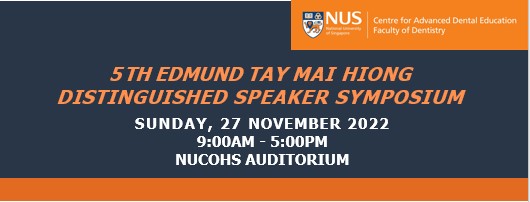Total Registrations: 70
Description
The Centre for Advanced Dental Education, Faculty of Dentistry organises an annual symposium centered on the topic of Sleep Medicine called the NUS Edmund Tay Mai Hiong (ETMH) Distinguished Speaker programme. The programme is being funded through a generous endowment from the Tay family in memory of the late Dr. Edmund Tay, who was a former Dean of the Faculty of Dentistry at the National University of Singapore (NUS).
The primary objective of this fund is to help raise awareness of the role of dentists in treating sleep related breathing disorders. This objective will be achieved through the Distinguished Speaker series which are aimed not only at the dental profession in Singapore and the region but also the medical professionals to illustrate the potential of suitably trained dentists to help manage this group of disorders.
The theme for the 5th ETMH symposium is "Designing Airway for Better Sleep: From Infant to Adult".
Distinguished Speaker : Dr Audrey Yoon
Lecture 1 - Find New Scientific Evidences from Everyday Practice
Synopsis :
- Understand the dentist’s role in identifying airway disorder in everyday practice
- Learn the screening protocols and spectrum of available therapies
- Comprehend tongue posture and craniofacial development
- Integrative and functional approaches to craniofacial structure modification : interdisciplinary approach
Lecture 2 : Orthodontist’s role for children with sleep disordered breathing
Synopsis
Most current orthodontic treatments for obstructive sleep apnea have focused on changing the anatomy to increase the airway space. However, most of orthodontists do not understand the mechanism how anatomical changes affect the pathophysiology of obstructive sleep apnea. Dr Yoon will show her extensive research for a better understanding the relationship between anatomical factor and physiology of OSA. Dr Yoon will discuss the early identification of the ethology and understanding the pathophysiology to prevent diseases. She will also discuss the orthodontic approach for modifying orofacial growth and development with newest technique to achieve ideal skeletal structures and to reprogram of orofacial muscle function.
Lecture 3 : Growth Modification Protocol : From Infant to Children ( Part 1)
Synopsis
As knowledge of sleep medicine increases, it is critical that other oral healthcare providers such as pediatric dentists and orthodontists are equipped with the knowledge to help contribute to interdisciplinary care for pediatric patients with obstructive sleep apnea (OSA). As our professions strive to bridge the gap between sleep surgery and orthodontics, it is imperative that providers have a clinical guideline to follow as patients grow and develop. Orthodontists can manipulate and guide craniofacial growth patterns depending on a patient's age; therefore, it is important to understand which strategies can be used in conjunction with other providers to help create a team-based approach to care.
With an orthodontist's extensive knowledge of the craniofacial growth and development stages, providers can take advantage of the therapeutic appliances that can make a substantial change in a patient’s growth pattern during maturity. As a child grows from infancy to adulthood the dentition and craniofacial complex change with various growth patterns that can be intercepted and targeted at the right time.
Lecture 4 : Growth Modification Protocol : Teenager to Adult ( Part 2)
Synopsis
What to do vs What not to do
How to design sleep surgery
Growth Modification Guidelines
- Understand specific orthodontic treatment options that can be offered from infant to adult with sleep-disordered breathing
- Define why early diagnosis and treatment of sleep disordered breathing is imperative for children’s growth and development
- Understand the differential growth of each craniofacial structure
- Understand when and how: selection and design of orthodontic appliance in the right place at the right timing
Date and Time
Sunday, 27th November 2022 9:00AM GMT+08:00
to
Sunday, 27th November 2022 5:00PM GMT+08:00
Organisation
Faculty of Dentistry
Contact Email
fodsymposium@nus.edu.sg
Location
NUCOHS Auditorium





